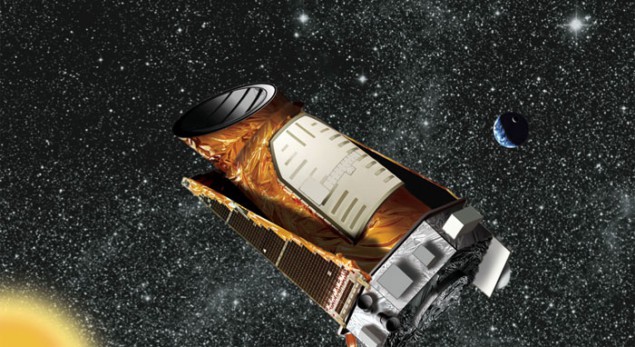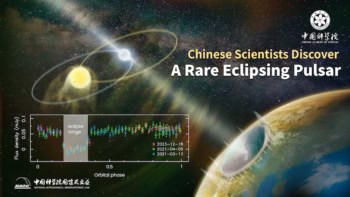
Flicker, flicker little stars
Now we know what your surface gravities are
This update of a classic nursery rhyme was inspired by astronomers in the US, who by serendipity have found a new method of measuring the strength of gravity on the surface of a star. Surface gravity is a key stellar parameter and having a new way to determine its value could lead to further insights into extrasolar planets (exoplanets), which are planets that orbit stars other than the Sun.
Surface gravity is important because it provides information about two fundamental properties of a star. These are its mass – which governs how the star behaves – and its diameter, which can affect estimates of the sizes of planets seen to be orbiting it.
Not surprisingly, the star with the most precisely known surface gravity is our own. The Sun is 109 times larger than the Earth and 332,946 times more massive, so simple calculations indicate you would weigh 28 times more there than here – if you could survive the heat. For more distant stars, surface gravity can be estimated using a spectroscopic technique, but only with an accuracy of 25–50%.
Spotted by Kepler
Now, Fabienne Bastien and Keivan Stassun of Vanderbilt University in Nashville, Tennessee, and colleagues have chanced upon a new method that can deliver an accuracy of 15–25%. The story begins with Bastien examining data from the Kepler space observatory, which makes very precise measurements of the brightness of stars. Kepler’s primary goal is to find the tiny dips in brightness that occur when orbiting planets pass in front of their stars.
For some stars, Kepler has also detected internal oscillations in brightness and Bastien noticed that the more a star’s light flickers during a period of eight hours, the lower its surface gravity. “It was an accident,” says Bastien, a graduate student who is using Kepler data to study stellar magnetic fields. “I actually did not quite know what to make of it.”
Stassun, her advisor, recalls what happened next. “She came into my office. ‘Look at this pattern’, she said. ‘It’s pretty dramatic. But what is it?'”
Rising bubbles
Bastien and Stassun then hit upon the answer. Most stars, including the Sun, have surface temperatures of less than 6500 K. Such stars have outer layers that are convective: their surfaces boil like a pot of water on a hot stove. Hot bubbles of gas rise to the surface; cooler ones descend.
Following the Stefan–Boltzmann law, the hot bubbles are brighter, so the star’s surface looks granulated, with dark areas surrounding bright ones. The granules, the astronomers think, cause the starlight to flicker. On a star with a high surface gravity, like the Sun, the granules are small, producing only tiny flickers. In contrast, a low-surface-gravity star, like a puffy red giant, has large granules and therefore larger flickers.
“Surprisingly nice, tight correlation”
“It’s an innovative technique to measure something interesting that will have impact on several different fields,” says Marc Pinsonneault, an astronomer at Ohio State University in Columbus who was not involved with the discovery. He calls the link between stellar flicker and surface gravity “a surprisingly nice, tight correlation”.
“What the flicker method will do is to greatly improve the accuracy of planet diameters,” Stassun says. Good estimates of planetary sizes help determine whether a far-off world is a gas giant like Jupiter, an ice giant like Neptune, or a rocky planet like Earth. Kepler scientists use the amount of starlight a planet blocks to estimate its size relative to its star. So determining the planet’s absolute size requires knowing the star’s diameter, which the flicker technique will provide via the surface gravity.
The flicker technique does have its limitations. It will not work on the hottest stars, which have outer layers that do not bubble. And the flickers are small, so the method requires a sensitive spacecraft such as Kepler. Kepler recently suffered a major malfunction, but NASA does plan to launch a successor, the Transiting Exoplanet Survey Spacecraft, later this decade.
Easier but less accurate than asteroseismology
The technique is also not as accurate as asteroseismology, which exploits a star’s internal oscillations to derive its surface gravity. “Nothing compares to asteroseismology,” says Stassun. “It really is the gold standard.” But flicker measurements are much easier to make than asteroseismic ones.
The new work also suggests that the Sun will someday lose its spots. Young sun-like stars have strong magnetic fields that pepper their surfaces with spots and flares, producing much larger stellar fluctuations than the flickers. But as stars age, their magnetic activity dwindles. Ultimately, they reach what Bastien and her colleagues call a “flicker floor”: no spots besmirch their surfaces and all variability arises instead from the granules.
At sunspot minimum, our star is already near this flicker floor. When will the Sun be completely spotless? “My guess is that we’re probably talking something in the neighbourhood of a billion years,” says Stassun.
The astronomers have published their discovery in Nature.



